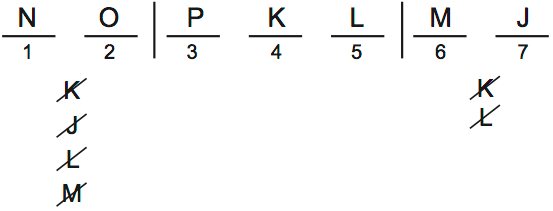This is an explanation of the first logic game from Section IV of LSAT 68, the December 2012 LSAT.
A realtor will show seven houses (J, K, L, M, N, O, P) to a buyer. You must place them in order.
This is a straightforward linear game, only slightly complicated by the addition of morning, afternoon and evening groups. Here’s how you can draw the groups separated:

I drew M, A, and E on this diagram just to make it clear. But I don’t actually think you need to include those on your diagram. You know intuitively that morning is first, afternoon second, evening last. So the two separator lines are enough to divide the groups. I’m leaving out M, A, E on the other diagrams.
You can draw the first and second rules directly onto the diagram.

I put J above evening to show that J goes in one of those two spaces. It doesn’t matter which one.
I also placed a ‘not J’ underneath morning, to remind myself that J can’t go there. Likewise, K is not in the morning.
Next, K – L – M must go in that order:
![]()
This affects our main diagram. K goes in the afternoon, at the earliest, because K can’t go in the morning (rule 2). Since L and M come after K, that means they also can’t go in the morning:

You could stop there, but there’s more to deduce. This is a fairly restricted game. First, let’s identify the random variables, those with no rules:

N, O and P have no rules. These are also the only variables that can go in the morning.
This is an important deduction. Two out of three of N, O and P must be in the morning. If one of N, O and P is not in the morning, then the other two are.
K and L are also quite restricted. They can only go in the afternoon. Why? Let’s try putting them as near to the end as we can:

There’s no space for K or L to be shown in the evening. J and M fill up the evening. J always has to be there, and M always comes after K and L.
So here’s the full diagram:

NOP are above the morning as a reminder that two of them go there. J is above evening because it must go there.
K-L are in the afternoon, so I placed them above that space.
M is somewhere after K – L. It could be in the afternoon or evening, so I put it between the two groups.
There’s no need to draw M there, but I find it helpful to be able to visualize all 7 variables above the main diagram, roughly where they must be place. It’s easy to waste time forgetting which letters are left.
It’s very important to understand the NOP and K-L deductions before moving on. Most of the questions test whether you understood that only NOP can go in the morning, and that KL can’t go in the evening.
A Simpler Diagram For The Questions
You don’t have to repeat the full diagram on all questions. I’m repeating the full diagram in my explanations only because (I hope) it makes these explanations clearer. I may edit these later to remove the M, A and E from the groups, I don’t think they’re necessary, and I wouldn’t have drawn them on my main diagram if I were just doing the game on my own.
But you should draw simpler diagrams on local rule question. Here is how I would actually draw the scenario I drew two diagrams above, if I were doing it in pencil for a question:

My main diagram has all the deductions, and I’ll refer back to that when building a local scenario. Do not draw in your main diagram when you do games, always make new diagrams for each question that requires them.


Leave a Reply